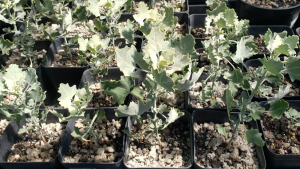
The Kona-Kohala Chamber of Commerce honored the University of Hawaiʻi at Hilo Center for Maunakea Stewardship (CMS) with its 2022 Pūalu Award for Community Education on Friday, June 24. The award honors organizations that promote and support education and enrichment programs that develop personal skills and lifelong learning. CMS was commended for its innovative efforts in native plant restoration and invasive species management.
“We are moved by this acknowledgement which helps shine a spotlight on our dedicated CMS staff members who pour their hearts into stewarding these precious lands,” said Nahua Guilloz, director of stewardship at CMS. “Enriching the ecosystem on the mauna helps to bridge other aspects of the project together that opens the door to educating and connecting with all who come to Maunakea.”

This is the third Pūalu award UH Hilo has received for its stewardship of Maunakea. In 2016, UH was recognized for its environmental awareness on the mauna and in 2017, for culture and heritage. Also in 2017, the Hawaiʻi Historic Foundation presented UH with a Preservation Commendation Award, the foundation’s highest recognition of preservation, rehabilitation, restoration and interpretation of the state’s architectural, archaeological and cultural heritage.
- Related UH News story: 2017 Pūalu Award, July 3, 2017
“The awardees demonstrate leadership while working together for the betterment of West Hawaiʻi,” said Wendy Laros, executive director at Kona-Kohala Chamber of Commerce.
Launched in 2019, the CMS native plant restoration project located around the Visitor Information Station at the 9,000 foot elevation on Maunakea, focuses on enhancing the area’s ecosystem with native plants that are both rare and common providing a habitat refuge for native birds and as climate change accelerates, help to slow erosion and the decline of valuable plants and animals.

As of November 2021, propagated native plant counts include: 495 māmane; 120 ʻāweoweo; 1,295 ʻenaʻena; 17 pāwale and 782 native grasses. Hundreds of native māmane also sprouted on their own. The endemic tree with yellow pea-shaped flowers once thrived in forests from mauka to makai, it is currently limited to sub-alpine environments on Maunakea and Maunaloa on Hawaiʻi Island.
“We’re also seeing plants we planted start to set flower and seed. And so we’re collecting seeds from those plants that we planted in our restoration area which is incredible for only two years of work,” said Jessica Kirkpatrick, CMS’ natural resource specialist. “It is an honor for our team to receive this recognition.”
As part of the restoration efforts, CMS built a greenhouse just above the restoration area with the help of community volunteers and donated supplies provided by local building source HPM Building Supply. The structure housing propagated native plants is the highest elevation greenhouse in the state and is an essential component of the restoration effort. The overarching goal is to host groups from local schools and the community to help collect, prepare, plant and eventually outplant back into the environment.
Invasive species management
Eradicating invasive species and weeds helps to reduce habitat for invasive ants on Maunakea, and prevents unwanted invasive species from being transported to the upper elevation areas. Since 2012, the Mālama Maunakea campaign connects community volunteers to help in resource management and stewardship of the Mauna Kea Science Reserve and mid-level support facilities at Halepōhaku. Since its inception, more than 8,600 pounds of invasive weeds have been removed from CMS’ restoration area.
- Related UH News story: Volunteers protect precious māmane on Maunakea, remove invasive weeds, February 11, 2020


